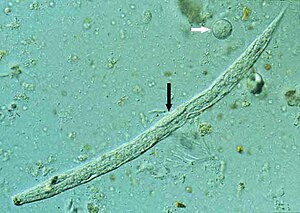Dwarf threadworm
| Dwarf threadworm | ||||||||||||
|---|---|---|---|---|---|---|---|---|---|---|---|---|

First larva of the dwarf threadworm |
||||||||||||
| Systematics | ||||||||||||
|
||||||||||||
| Scientific name | ||||||||||||
| Strongyloides stercoralis | ||||||||||||
| A. Bavay , 1876 |
The dwarf nematode ( Strongyloides stercoralis , from ancient Greek στρογγύλος strongúlos "round", and -ειδής -eidés "-like, -shaped") is a parasite that attacks humans and occurs without an intermediate host , but with a free- living phase. An infection with the pathogen, which is rare in Central Europe, is known as strongyloidiasis , the clinical picture also as anguillulosis .
distribution
Its main distribution is in the tropics, but it is occasionally found in temperate areas where it can cause family or community infections.
features
The females in the intestine reach a size of up to 2.7 mm, whereas the free-living ones are a third smaller. The males reach a length of up to one millimeter.
Life cycle
The cycle runs in two phases. The adult females settle in the human intestine and lay up to 2000 eggs a day parthenogenetically . The first larva hatches from these and either gets outside with the faeces or develops into the third larva via a further larval stage. The third larva bores into the blood vessel system via the mucous membrane of the large intestine or the anal skin . From there it travels via the lungs to the bronchi , via the trachea back to the intestine, so that a new population is created. However, if the first larvae are excreted, they develop into filariform larvae, which then penetrate a new host through the skin . Another path that the first larva can take after leaving the host is to develop into adult males or females. After these adults have mated, the female lays eggs, which then become filariform larvae, which, as described above, penetrate the skin or are ingested through the mouth. Now the cycle starts all over again. The exact mechanisms of reproduction are still unclear.
Harmful effect
The infection can become chronic and thus persist for decades without being adversely affected. Dwarf roundworm infection can lead to inflammatory ulceration in the upper small intestine. In the case of massive infestation, symptoms of pneumonia can occur, which are caused by the irritation of the larvae emerging through the windpipe. The anus is also itchy due to the larvae penetrating the anal skin. The infection becomes life- threatening in people with suppressed or damaged immune systems ( AIDS , cancer ), or through treatment of the symptoms caused by the larvae exiting the lungs, as corticosteroids are usually used, although these may be similar to a growth hormone in worms exhibit, so that there is a mass increase that can be life-threatening. Other causes are the reduction in eosinophilic granulocytes caused by corticosteroids .
Diagnosis of strongyloidiasis
The suspicion of strongyloidiasis usually arises from the clinical appearance of the patient with corresponding gastrointestinal symptoms, as well as blood eosinophilia and increased serum IgE. Filter methods such as the Baermann-Wetzel method , agar plate methods or direct detection in the stool are available as diagnostic options . The microimmunofluorescence (MIF) method can also be used, cf. a. Immunofluorescence . Antigen ELISAs are also used, but cross-reactions with other helminthiasis have been described. Finally, detection by means of PCR is becoming increasingly important.
Antiparasitic Treatment
Infections with dwarf threadworms can be treated with ivermectin , or alternatively with albendazole , mebendazole or thiabendazole .
See also
Individual evidence
- ↑ Hans Adolf Kühn: Round worms (Nemathelminthes). In: Ludwig Heilmeyer (ed.): Textbook of internal medicine. Springer-Verlag, Berlin / Göttingen / Heidelberg 1955; 2nd edition, ibid. 1961, pp. 837-840, here: p. 840.
- ↑ Hans Adolf Kühn: Round worms (Nemathelminthes). In: Ludwig Heilmeyer (ed.): Textbook of internal medicine. Springer-Verlag, Berlin / Göttingen / Heidelberg 1955; 2nd edition, ibid. 1961, pp. 837-840, here: p. 840.
- ↑ AA Siddiqui, CS Stanley, PJ Skelly, SL Berk: A cDNA encoding a nuclear hormone receptor of the steroid / thyroid hormone-receptor superfamily from the human parasitic nematode Strongyloides stercoralis. In: Parasitology research. Volume 86, Number 1, January 2000, pp. 24-29, PMID 10669132 .
- ^ Marianne Abele-Horn: Antimicrobial Therapy. Decision support for the treatment and prophylaxis of infectious diseases. With the collaboration of Werner Heinz, Hartwig Klinker, Johann Schurz and August Stich, 2nd, revised and expanded edition. Peter Wiehl, Marburg 2009, ISBN 978-3-927219-14-4 , p. 294.